The third and final day of a long weekend of tours today. With the wind in the east, it felt like there should be some migrants around, so we started off in Wells Woods.
We walked up to the bushes by the lifeboat station first. A flock of Long-tailed Tits worked their way in towards us and in amongst them were a couple of Goldcrests, the first of many we would see today. A Song Thrush sat in the sea buckthorn, a grey-backed continental migrant, presumably fresh in overnight. There were lots of Brent Geese out on the other side of the harbour, with plenty of waders scattered amongst them, mainly Oystercatcher and Curlew. A couple of little flocks of Sanderling were feeding along the sandy shoreline.
We walked into the trees, with lots of Goldcrests calling from the trees above our heads. There are always Goldcrests in the woods here, but there seemed to be more than usual. However, the walk up to and around the Dell was rather quiet. It was cool, it had rained overnight, and there was a very flesh easterly, so perhaps the birds were seeking the more sheltered areas?
We worked our way round onto the main path and walked west. We hadn’t gone far when we heard a pipit calling over the trees, a rather weak and weedy ‘speez’. There are several pipits with a similar call, the commonest of which here is Tree Pipit, but it didn’t sound like a Tree Pipit. It called several times in quick succession and we turned to look for it, but couldn’t see it as it disappeared over. Very frustrating!
There were also lots of thrushes coming in. We could hear little groups calling continually over the trees, a mixture mainly of Song Thrushes and Redwings. A single Mistle Thrush appeared in the tops of the pines briefly, before flying off west towards Holkham. There were also finches calling overhead – Siskins and a few Redpolls again, and more Bramblings today. We heard a couple of single birds calling, and then a flock of four silent birds circled over. We could see there orange breasts contrasting with much whiter underparts.
We struggled to find the tit flocks today. We found one, but it moved quickly away from us into the top of the pines, where it was very hard to follow. We could see Long-tailed Tits, Blue Tits, Great Tits and Coal Tits, and several more Goldcrests. We could hear Treecreepers calling. Most likely, given the cool and windy conditions, the birds had moved deeper into the pines to feed.
We made our way west to the trees beyond the drinking pool, and then turned back. It was only when we got back by the Dell, that we came across another tit flock. They were in the tops of the pines once again, but from higher up in the dunes we could get a better look at them. We watched them for a while, seeing all the same regular species – Long-tailed Tits and Coal Tits, and lots of Goldcrests. Then suddenly a crest started calling from low down in the tree right beside us. We turned to see a black and white striped face – a Firecrest. It fed in the tree in front of us for a few seconds, then flew off to join the rest. It was hard work in the trees today so, after a couple of hours, we decided to head west to Titchwell to look for some waders and wildfowl instead.
We had a bit of time before lunch once we arrived, so we walked out along the Fen Trail towards Patsy’s Reedbed. Another flock of tits passed overhead as we walked along the boardwalk – there was no escaping the Long-tailed Tits and Goldcrests today! A Common Darter was basking in the sunshine out of the wind on the back of Fen Hide.
 Common Darter – out of the wind and in the sun on the back of Fen Hide
Common Darter – out of the wind and in the sun on the back of Fen Hide
As we walked up to Patsy’s Reedbed, we could see a steady stream of Ruff and Black-tailed Godwit flying across the path ahead of us, up over the hedge and down onto the stubble field beyond. There were a lot more Ruff around the muddy edges and islands as well – we counted at least 35 on Patsy’s Reedbed today.
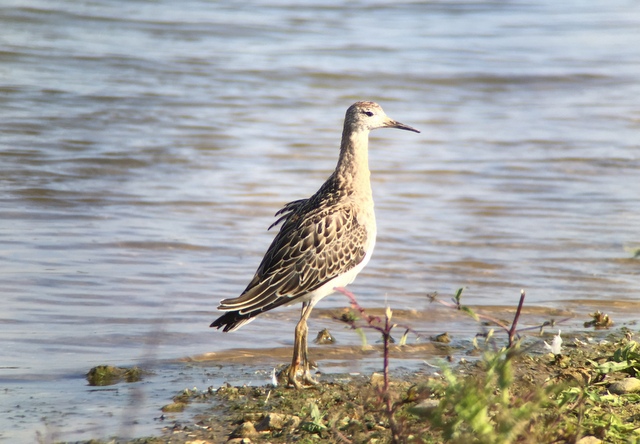 Ruff – one of at least 35 on Patsy’s Reedbed today
Ruff – one of at least 35 on Patsy’s Reedbed today
The waders kept flying back and forth between the fields and the water. We could see quite a few 1st winter Black-tailed Godwits, with retained juvenile patterned wing coverts but plain grey upperparts. However, one Black-tailed Godwit was still mostly in juvenile plumage – quite rusty coloured on the breast.
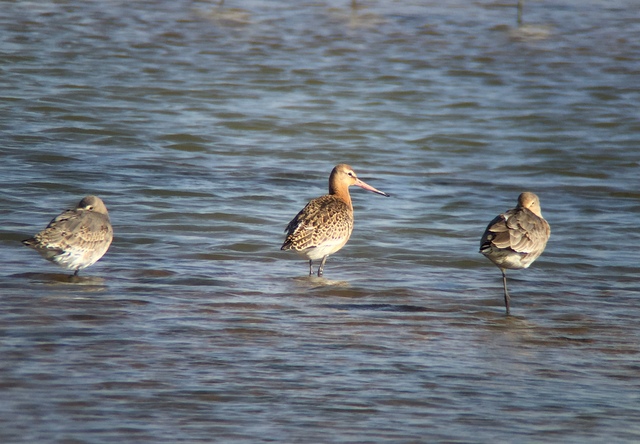 Black-tailed Godwit – the middle bird still mostly in bright juvenile plumage
Black-tailed Godwit – the middle bird still mostly in bright juvenile plumage
There were plenty of ducks on Patsy’s Reedbed today as well – mostly Mallard, Wigeon and Teal. A small number of Common Pochard and Tufted Duck were diving out on the water. On the edge of one of the islands, we could see the unmistakable bright orange hairdo of a couple of drake Red-crested Pochard. Nearby, a couple of pale-cheeked females were sleeping. As we scanned back and forth, more appeared – at least 10 Red-crested Pochard in total today. It had been a productive session out here, but it was time to head back for lunch – so that we could do the main part of the reserve afterwards.
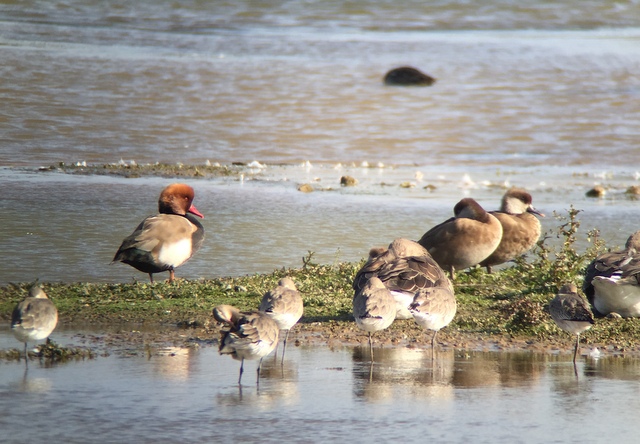 Red-crested Pochard – an orange-headed male & two pale-cheeked females
Red-crested Pochard – an orange-headed male & two pale-cheeked females
We walked out onto the reserve after lunch. The grazing marsh pool held a couple of Lapwing, two Ringed Plover and a Redshank. The recent rain had left a couple of puddles, but it is still largely drained. A Kingfisher flashed past along the edge of the reeds and disappeared over the back. The reedbed pool was rather quiet today, with no sign of the raft of Common Pochard which has been there recently.
As we approached Island Hide, we could see a crowd of photographers clustered around the railings along the access ramp. When we got to them, we could see why. There were lots of Goldcrests in the sallows, feeding feverishly on the sunny side, out of the wind. We stood and watched them for a while as they fluttered around only a few feet in front of us. They were obviously fresh in from over the sea, and were desperately looking for food. Interestingly, as we returned back this way later in the afternoon, the sallows were quiet as most of the birds had obviously moved off inland towards the trees.
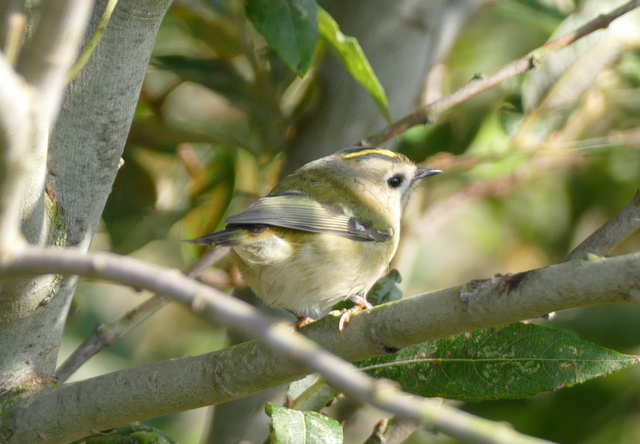 Goldcrest – a fresh arrival, looking for food in the sallows
Goldcrest – a fresh arrival, looking for food in the sallows
As we stood and watched the Goldcrests, a single Chiffchaff appeared in the same bushes with them, also fluttering around close in front of us looking for food. Again, it was probably fresh in from the continent.
 Chiffchaff – probably also a fresh arrival in the sallows
Chiffchaff – probably also a fresh arrival in the sallows
As usual, there were lots of birds out on the freshmarsh. The waders were dominated by a large flock of Golden Plover roosting on one of the islands. We got them in the scope and could see their golden-spangled upperparts. Several Black-tailed Godwits were also sleeping out there, together with two Avocets. Numbers of the latter are now well down from the huge numbers of late summer. A few Dunlin were scattered around the muddy margins.
Among the ducks, the males are now gradually emerging from eclipse. The drake Teal are a really variable mixture of brown eclipse and smart breeding feathers. There were still lots of rusty brown Wigeon as well as a scattering of Pintail in various states of moult.
 Teal – a moulting drake, with a mixture of old eclipse and new breeding feathers
Teal – a moulting drake, with a mixture of old eclipse and new breeding feathers
We made our way on towards Parrinder Hide, but as we got to the junction in the path, we could see a Curlew Sandpiper further along, by the main tidal channel out on the Volunteer Marsh. We continued on along the main path until we were level with it – and got a great look at it through the scope as it fed on the mud, initially with a couple of Dunlin, before walking and running off on its own.
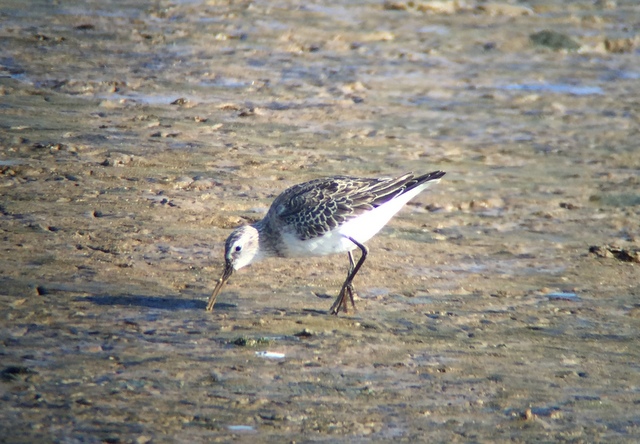 Curlew Sandpiper – feeding out around the Volunteer Marsh again today
Curlew Sandpiper – feeding out around the Volunteer Marsh again today
There were a few other waders out on the Volunteer Marsh as well, a good smattering of Redshank, Curlew and Grey Plover, plus a couple of Ringed Plover. A single Bar-tailed Godwit flew in and landed out on the mud. A Greenshank flew over calling and disappeared off towards Thornham saltmarsh.
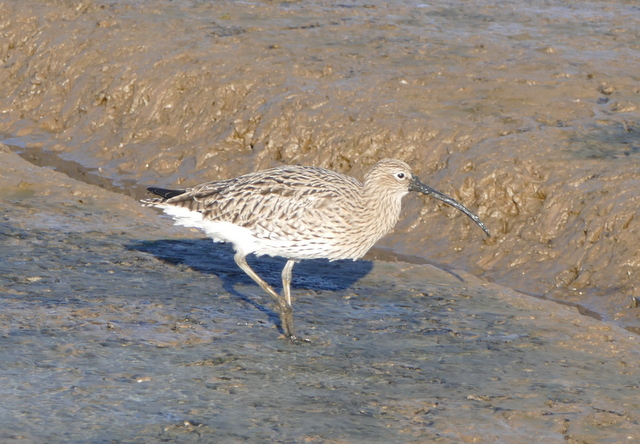 Curlew – also feeding out on the Volunteer Marsh
Curlew – also feeding out on the Volunteer Marsh
Having come this far, we decided to continue out towards the beach. The Tidal Pools held the usual selection of waders – Black-tailed Godwits, Redshank and Grey Plover, plus more Dunlin sleeping on the muddy spits. The tide was on its way in, but there were still lots of birds around the rocks out on the beach. We could see lots of dumpy grey Knot among the Oystercatchers, as well as a few Turnstones. Looking more closely, we picked out a couple more Bar-tailed Godwits as well. A long line of Sanderling were running along the beach down towards the water’s edge.
The sea itself was rather quiet today. A single Great Crested Grebe was diving close in just off the rocks, but still more were further out on the choppy waters. A lone Sandwich Tern flew past just offshore. It was quite cool out on the beach, so we decided to head back.
We hadn’t been in to Parrinder Hide on the way out, so we stopped off their on our way back. With the rising tide, a large flock of Bar-tailed Godwit and Knot had now gathered to roost on the freshmarsh. Nervously in and out of the vegetation on the bank were at least four Snipe.
 Snipe – at least four were feeding along the bank from Parrinder Hide
Snipe – at least four were feeding along the bank from Parrinder Hide
There were lots of Shoveler feeding in the deeper water right in front of the hide, helpfully keeping their heads almost permanently down in the water. The drakes are really starting to emerge from eclipse now.
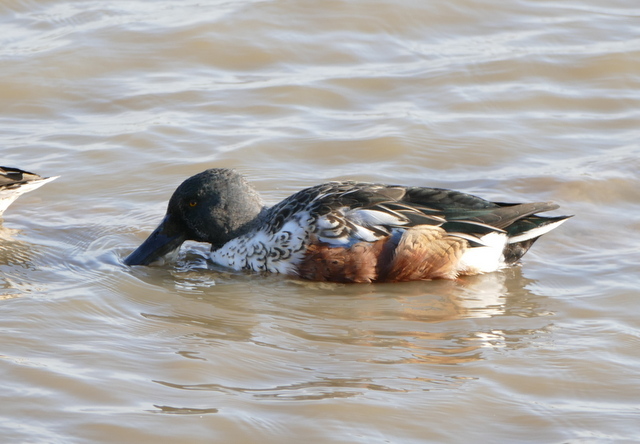 Shoveler – a drake emerging from eclipse
Shoveler – a drake emerging from eclipse
Back at the junction with the main path, a quick glance at the Volunteer Marsh was just in time to catch a Greenshank dropping in nearby. It only stayed for a second or two, before it was chased off by a Pied Wagtail!
Back at the drained grazing marsh pool, we stopped to look at a Chinese Water Deer which was feeding along the edge of the reeds right at the back. Down at the front, right on the edge of the reeds, we spotted a Grey Wagtail feeding quietly. We had heard one or two calling overhead earlier in the morning, so it was nice to actually see one now.
We swung back round via Meadow Trail. Even though it was cool and breezy, the sun was shining, so we thought it might be worth looking for migrants in the bushes. No surprises, we came across another flock of Long-tailed Tits and lots of Goldcrests. There had been the continual sound of Song Thrushes and Redwings coming in overhead through most of the afternoon, and we saw several new arrivals dropping into the bushes later on today, fresh in from Scandinavia.
As we wound our way round towards Fen Trail, we heard a Yellow-browed Warbler calling from the sallows further in. There has been one here for a while now, but it had proven rather elusive all day today. We stood at one likely spot and scanned, but there was no sign of it. Still it was nice to get one again today – making a full house for the long weekend! Then it was time to head for home.
















